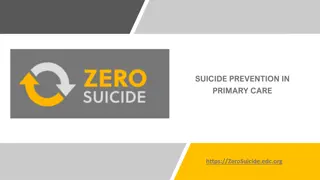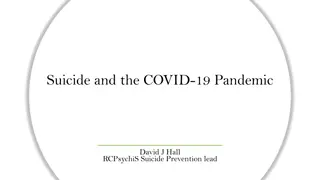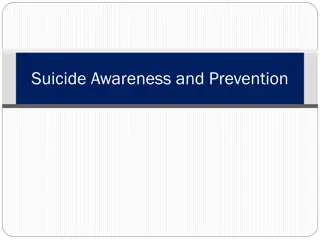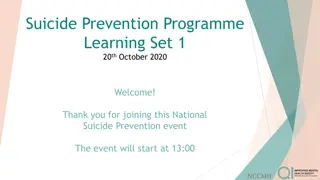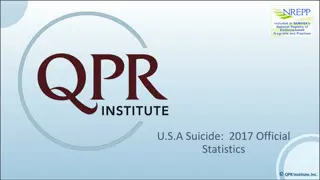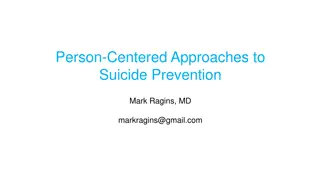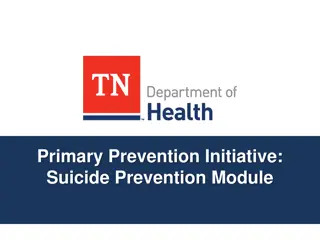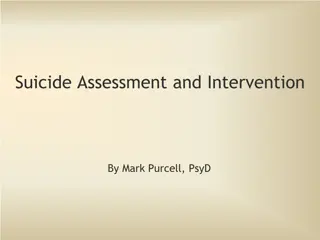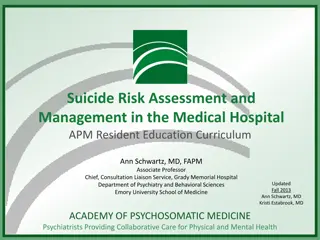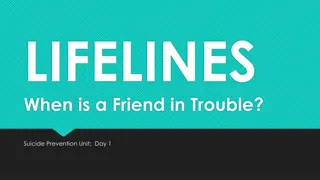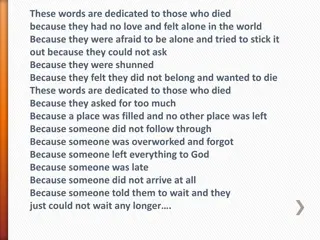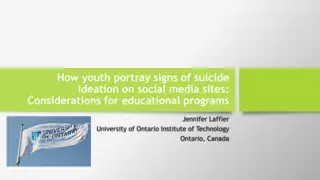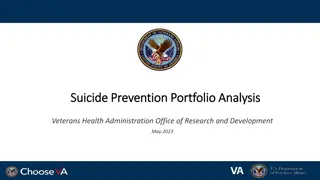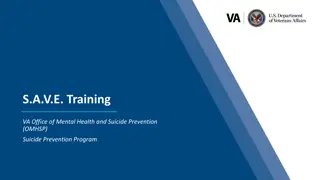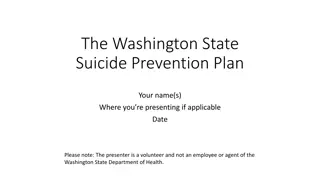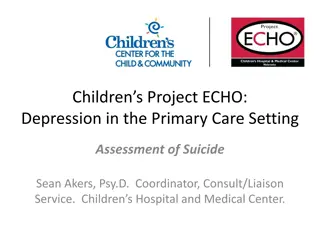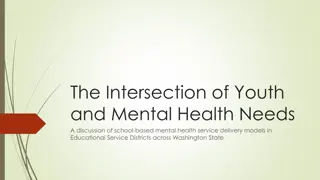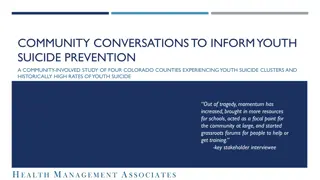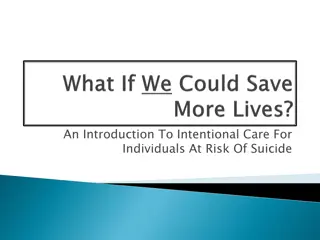Understanding Suicide Prevention: Theory, Assessment, and Intervention
Explore the complex problem of suicide, risk factors, and protective measures. Gain insights into a novel conceptualization of suicide risk related to perceived loss of life meaning. Delve into a theory in social work that sheds light on suicide risk factors. Learn about practical suicide prevention interventions and how to create tailored safety plans.
Download Presentation

Please find below an Image/Link to download the presentation.
The content on the website is provided AS IS for your information and personal use only. It may not be sold, licensed, or shared on other websites without obtaining consent from the author. Download presentation by click this link. If you encounter any issues during the download, it is possible that the publisher has removed the file from their server.
E N D
Presentation Transcript
Suicide Prevention: Theory, Assessment and Intervention Joseph Hunter, PhD, LCSW
Disclaimers The material presented is based on work supported in part by the Veterans Administration (VA). The views expressed in this presentation are those of the author and do not necessarily reflect the position or policy of the VA or the US Government. Although a few aspects of this presentation directly pertain to my work at VA in the area of suicide prevention, I am presenting independently and not as part of my role as Suicide Prevention Coordinator at the VA.
Objectives Learn about the problem of suicide, and risk and protective factors Learn a new conceptualization of suicide risk Become familiar with a new theory in social work that offers explanation for a central feature of suicide risk- loss of perceived life meaning and purpose Learn about an application of the theory that is a brief suicide prevention intervention Learn how to conduct tailored and meaning- based safety plan 3
Suicide Statistics There were 39,501 in 2011 Women attempt suicide more frequently; less likely to succeed Majority suicides are by men Majority by gun Majority have one or more prior attempts
High Risk Populations Doctors Farmers Veterans Native Americans Others
"What treatment, by whom, is most effective for this individual with that specific problem, under which set of circumstances?" Gordon Paul, 1967
Treatment Population Dimensions Age/Developmental Stage (consider family, peer group school, etc.) Special Needs (consider COA/SA, MI, Conduct, etc.) Chemical Use Severity ( consider orientation to change) Unique Characteristics (consider ethnicity/culture, age, gender, etc.)
Sample A purposive, non-probability sample 1150 client discharges Adolescent sensitive programs 27 identified OASAS-Certified outpatient programs Only those clients who stayed at least 30 days and had at least four visits (removed 320).
Independent Variables (the interventions under consideration) Strong Family Program Strong Vocational Program Strong Group Programs Strong Behavioral Focus Strong in Case Management Multi-Service Program
Other Study Variables Dependent Variable (the outcome variable used to evaluate the programs success) Overall Goal Achievement Control Variables (those relevant variables impacting the outcome) Characteristics including age Ethnicity Gender Age Special needs and AOD history Co-Occurring MI Parental Alcoholism and/or Drug Addiction Criminal Justice Involvement Drug Use Severity Other Treatment Conditions Length of Stay
Intervention Associations for Improved Odds of Goal Attainment Age 15- COA/SA DU Sev JJ Issue Girls SGI SFI Boys Whites SVI SBI Blacks Latinos SMI Age 16+ MI Treatment Completion SGI is Strong Group Intervention; SFI is Strong Family Intervention; SVI is Strong Vocational Intervention; SBI is Strong Behavioral Intervention; SMI is Strong Multi-Service Intervention. The heavier lines indicate an overall population effect for the interventions; the dotted line shows an effect from the intervention from certain subgroups; the solid line show the specific subgroups whose odds of completion were linked to specific interventions.
Known Risk Factors Previous attempt (but not necessary!) Alcohol or substance abuse History of mental illness Poor self-control Hopelessness Recent loss (physical, emotional, financial) Family History of suicide 13
Known Risk Factors History of abuse Serious health problems Chronic pain Access to weapons Sexual identity concerns Recent discharge from higher level of care 14
Known Protective Factors Strong interpersonal connection(s) Therapeutic alliance with a behavioral health or medical provider Caretaking role Good problem solving abilities Will to live Resilience Good treatment compliance Negative attitude about suicide Strong spiritual/religious/cultural beliefs Good reality testing
Risk Assessment: A Guiding Conceptualization
If you see what could be just the tip, GO DEEPER!
Suicide Risk Determination Life Engagement Vulnerability Poor Coping Capacity Death Ideation & Preparation Suicide Risk Emotional Vulnerability Subjective Burdens
Dimensions of Life-Disengagement Vulnerability
Coping capacity Impulsivity Expresses feelings Decision making and Problem Solving Avoidance vs. Acceptance Alcohol and Substance Use Help seeking behavior Willingness to take prescribed medication Accepts respon- sibility Prone to violence
Subjective Burdens Work or school circumstances Legal concerns Mood or energy level changes Change in medications Other Inability to enjoy hobbies relationships Spousal relationship Housing or Transportation Boredom or too much free time Childcare or child rearing Sources of Increased Stress, Focus or Concern Pain Finances
Death Ideation and Preparation Suicide seems like best option Access to means Nature/ Severity of past attempt Belief: better off dead Willingness to do a safety plan Wish to be dead Exposure to death/ dying Ideation within 30 days Attempt history Suicide of close friend or relative Recent attempt plan or attempt Prepara- tions made Rehearsed strategy Current plan Preoccupied with death/ No fear of death / dying Intent to die Suicide Note dying
Tips Suggesting Possible Increased Risk Examples: Excessive eating or drinking to escape stress Poor ability to express feelings Lying to avoid responsibility Examples: Isolation/few social connections Unemployed Diminished abilities Poor Coping Life Engagement Vulnerabilities Examples: Financial strain Boredom Pain Examples: Statement: better off dead Poor medication compliance Easy access to weapons Death Ideation Preparation Subjective Burdens Examples: Hopeless about treatment progress Inability to make positive changes Anxious or irritable Emotional Vulnerabilities
Sequencing Assessments Subjective Burdens Death Ideation & Preparation Poor Coping Life Emotional Vulnerabilities Engagement Vulnerabilities
What might you see on the surface? Talk about death, dying or the afterlife Taking too much or too little medication Heightened agitation and anxiety Known access to weapons Financial concerns Loss of spouse Declining health and abilities Isolation Disinterest in wellbeing Signs of alcohol or cannabis abuse Difficulties with sleep
Subjective Burdens What is of increased stress, focus or concern at this time? Partner/spouse relationship Financial situation Housing or transportation Legal issues Boredom or too much free time Lack connection to organizations Inability to enjoy usual hobbies Loneliness or isolation Change in medications Pain or health condition Family relationships
Death Ideation and Preparation Recent (not just current) suicide thoughts or plan History of a suicide attempt Nature of prior attempt(s) and plan(s) Wish/will to be dead Exposure to death and dying (e.g., combat exposure or relative/friend suicide) Preparations for suicide Writing or talking about suicide, death or dying Ready access to means (especially those considered) Rehearsed strategy
Coping Skills Impulsivity *Alcoh0l or other substance abuse/medication misuse Decision making and problem solving Help seeking behavior Accepts responsibility Prone to violence Ability to express feelings Seeks out help/avoidant Willingness to take prescribed medication
Life-Engagement Vulnerabilities Perceived loss of life meaning and purpose Nature of social connectedness: belonging and burdensomeness Feeling unappreciated Feeling ineffectual
Emotional Vulnerabilities Hopelessness Feeling trapped Feeling highly anxious Shame/guilt
If you see what could be just the tip, GO DEEPER! Subjective Burdens Poor Coping Death Ideation Preparation Life Engagement Vulnerabilities Emotional Vulnerabilities
Suggested Pathway Through Risk Assessment Subjective Burdens Death Ideation & Preparation Poor Coping Life Engagement Vulnerabilities Emotional Vulnerabilities
Interpersonal-Psychological Theory of Suicide Behavior Major Logical Propositions Lethal self-injury is associated with so much fear and/or pain that most avoid; however, one can develop the capacity to enact lethal self-injury. Desire to act to harm self is also necessary. Perceived burdensomeness and failed belongingness may drive the desire.
Interpersonal-Psychological Theory of Suicide Behavior (Joiner, 2005) Process of Change Build the therapeutic alliance as a potential source of belongingness Cognitive and behavioral intervention to address perceived burdensomeness
Interpersonal-Psychological Theory of Suicide Behavior Treatment Aims Therapeutic relationship is a source of help, care and support, so clinical approaches should highlight the therapeutic relationship. Foster sense of belongingness through challenges to validity of cognitions in support of burdensomeness and lack of belonging. Help the patient develop activities of contribution.
Perceived Life Meaning & Purpose Using the Geriatric Suicide Ideation Scale (GSIS; Heisel & Flett, 2006), Heisel and Flett (2008) have specifically explored the association between suicide ideation and a number of risk and resiliency factors for older adults (ages 67 to 98) in community, residential, and health care settings. Utilizing hierarchical multiple regression analyses, they found that resiliency factors in general and perceived meaning in life in particular (t=-3.17, p=.002) explained significantly added variance of suicide ideation (above and beyond mental and physical health problems).
Additional Protective Factors In a Swedish study (Rubenowitz et al., 2001) found only two factors for seniors that were associated with a decreased risk for suicide: Having a hobby (for men, OR .34, CI .16-.75, p=.05; for women, OR.27, CI .11-.69, p=.05) and Active participation in an organization (for men, OR .42, CI .17-1.0, p=.05; for women, OR.23, CI.07-.74, p=.05)
Stressors and Support Krause (2004) surveyed a US sample of 530 age 65 and older non- institutionalized, retired, English-Speaking adults to explore how meaning in life, stressful events, and health are interconnected. Utilizing hierarchical linear regression strategies, he found that stressors arising within highly salient life roles tend to erode a sense of meaning and purpose (B=-.066, p<.05). Also, at the lowest observed emotional support score, events arising in highly salient roles are associated with sharp decline in life meaning (B=-.283, b=-1.211, p<.001), but the size of this effect is not maintained at the higher levels of emotional support. After further supplemental review of the interactions, it was revealed that emotional support appears to help older people cope more effectively with stress by restoring their sense of meaning in life.
Self Preservation Theory (SPT) (Joseph Hunter) SPT is concerned with the social evolution of humans and suggests that human identity is inextricably linked to social belongingness Suggests people are innately driven to be active contributors to the wellbeing of their social groups of belonging Suggests that when one is utilizing his/her strengths to contribute to a social group or passion of his her preference, a perception of having life meaning and purpose results
Self Preservation Theory (SPT) Perceived life meaning and purpose is reinforced when one can see the unique benefits of one s contribution and receives affirmation for the same The desire to be dead that accompanies self- directed violence with suicide intent is fundamentally born out of one s perception of lacking mutually beneficial belongingness and a missing sense of social contribution Implication: Individuals can realign life pursuits to reestablish a sense of life meaning and purpose
Passions Strengths M & P Goal-Directed Action Me Reinforced by visible benefit & positive feedback Us Benefits All of Us Figure I. Self-Preserving Orientation M & P refers to life meaning and purpose.
Reinforced by by success in achieving desired benefit. Benefits Me Goal- Directed Actions M & P Passions Strengths Psychological Dissonance Us All of Us Social Dissonance Figure II. Self-Serving Orientation, Example A M & P refers to life meaning and purpose.
Paradigms for suicide prevention Risk Protection Connections with Others who care and appreciate Capacity: lack of fear of death Life Meaning and Purpose Suicide Capacities to effect positive difference Desire: e.g., Burden & Lack of Belonging Life roles in service to others/cause Means and Motive in the Moment
Suicide Risk Assessment Tips Remote to recent events Check on subjective experience Be conservative; err on the side of caution Avoid reliance on ideation alone Remember method matters Guns Consider risk associated with the 5 domains presented Seek consultation when in doubt Co-occurring mental health and alcohol or substance use disorder Don t be afraid to go with your gut
The SIMPLE Intervention for Older Adults (based on SPT)
SIMPLE: building on. Strengths according to Interests to develop Meaning and Purpose in Life Experiences Growing (back) the passion to live


